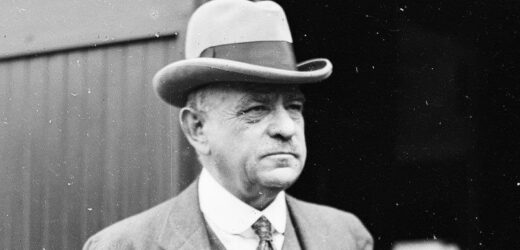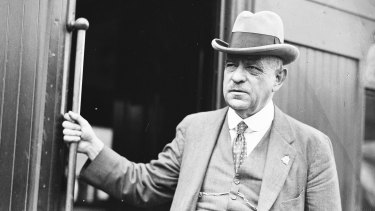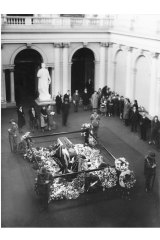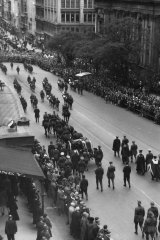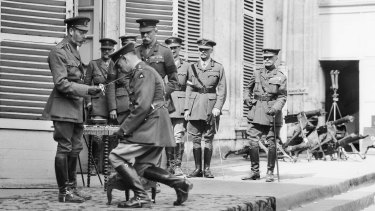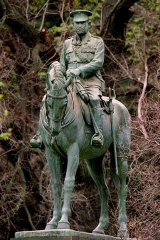First published in The Age, October 9, 1931.
DEATH OF SIR JOHN MONASH
GREAT SOLDIER AND CITIZEN
MOURNED BY NATION
STATE FUNERAL ON SUNDAY
Sir John Monash, 1929.Credit:Staff photographer
Sir John Monash, leader of the A.I.F. in the Great War, and subsequently Chairman of the State Electricity Commission, died yesterday morning at his home, “Iona,” St. George’s-road, Toorak. Death took place at 10.55 a.m. from pneumonia, supervening on the acute heart attack by which he was overcome last week. He was 66 years of age and had been in failing health for some months.
News of Sir John Monash’s death was received with profound sorrow by the whole community, by whom he was regarded as a great military leader, a distinguished citizen and a kindly man. Flags were flown half-mast on public and commercial buildings throughout the city, and an offer was promptly made by the Commonwealth Government, through the Defence department, for a State funeral. The offer was accepted by the relatives, and the burial will take place on Sunday, with full State and military honors, at Brighton Cemetery, where his wife was buried.
Since the death of his wife, over ten years ago, Sir John Monash spent most of his private life with his daughter (Mrs. G. Bennett), her husband (Dr. G. Bennett) and their children. He was particularly devoted to his grandchildren, and when one little grandson died last year Sir John Monash suffered a blow which visibly impaired his health. For some time past he had been aware of serious symptoms in relation to his health, but he was anxious to live to see the completion of the Shrine of Remembrance, in the planning and erection of which he was intensely interested. Nevertheless, he declined to take leave and rest from active business, and up to a fortnight ago, when his heart could bear the strain no longer, he carried on his administrative work at the office of the Electricity Commission.
BODY TO LIE IN STATE
FUNERAL FROM PARLIAMENT HOUSE
Sir John Monash lying-in-state in the Queen’s Hall, Parliament House, Melbourne.Credit:The Age Archives
After consulting with the Speaker of the Legislative Assembly yesterday, the Premier arranged to make Queen’s Hall, at Parliament House, available, so that the public would have an opportunity to pay tribute to the great war leader. People may place wreaths at the foot of the casket as they pass.
A short service will be held at Queen’s Hall on Sunday afternoon prior to the departure of the funeral.
The funeral will leave Parliament House at 2 p.m. on Sunday for Brighton Cemetery. The route will be via Spring, Collins and Swanston-streets; St. Kilda-road; High-street, Brighton; and Point Nepean-road, Elster-avenue, Lantana-road and North-road. The military funeral will be divided into two parts the first from Parliament House to the Shrine of Remembrance, and the other portion from the intersection of Elster-avenue and Lantana-road, Garden Vale, to Brighton Cemetery.
During the lying-in-state a continuous guard of four sentries will be placed over the casket. The troops for the ceremony from Parliament House to the Cenotaph will be drawn from those whose head quarters are situated north of the Yarra; those for the remainder of the ceremony will be drawn from head quarters south of the Yarra. Railway fares will be paid for troops intending to march.
A GREAT AUSTRALIAN
BRILLIANT A.I.F. LEADER
Organiser of “Germany’s Black Day”
General Sir John Monash was one of the ablest leaders in the war of 1914-18; an engineer and artillerist who organised human and mechanical resources to the task of smashing German resistance; a “civilian soldier” who, inspired by a firm courage and resolute will, imbued Australian troops in the field with a sense of moral superiority, and not only, led them to victory, but retained in after years their affectionate attachment. No men had a shrewder judgment of the qualities of the leaders set over them than the Australian “Diggers” in the war; and their warm, faithful regard for Sir John Monash, the leader of Anzac day marches year after year, provided sufficient proof of their opinion of him in this respect.
The funeral cortege travels down Collins Street on the way to Brighton Cemetery.Credit:The Age Archives
Before the outbreak of war in 1914 Colonel Monash, as he then was, had already shown a bent for soldiering, but he was primarily a civil engineer in private practice. At the time of his appointment to the Australian Imperial Forces he had seen much military service with the militia and citizen forces. His first commission be received in 1887, being attached to the militia Garrison Artillery. In 1903 he became a major in the Australian Garrison Artillery, while in 1908 he was appointed to the rank of lieutenant-colonel in the Intelligence Corps. In 1913 he was given the command of the 13th Infantry Brigade, citizen forces.
Early in the war he volunteered and was given command of the 4th Infantry Brigade, with the rank of colonel, and he left Australia in December, 1914. This brigade, on its arrival in Egypt, was attached to the New Zealand troops under Major-General Godley, the men thus forming the combined Australian and New Zealand Division. Colonel Monash showed his capacity for organisation during the period of training; and after the landing at Anzac he quickly proved that he was well fitted for the control of a brigade serving at the front. His men were landed near the famous Shrapnel Gully, up which they stormed on that first day, taking a position at the head of the gully, which was afterwards christened “Monash Gully.” This the 4th Brigade seized and held grimly for the next five weeks. It was always a position of responsibility, as it was a spot where the enemy might have broken through at any moment. During this period Brigadier-General Monash—he was promoted for his services—showed that he was possessed of foresight, and was considerate for his men.
He never worked his men to a standstill, but always “kept something up his sleeve,” and he never was short of the necessary stores. After five weeks the brigade, which had lost a large number of men, was formed into an army corps reserve, and vacated its position, after being thanked by the general officer commanding for its services in Monash Gully. In the final great battle in August the brigade came again into action. General Monash was then awarded the honor of C.B.
Painstaking Methods
After a period of service in the Suez Canal Defence zone Sir J. Monash transferred to France, and was promoted major-general in command of the 3rd Australian Division. This was early, in 1916, from which time onward he exercised almost continuous responsibility till the Armistice. His leadership of the 3rd Division, which, like the other Australian units, was engaged repeatedly in France and Belgium, was signally successful. He acquired a reputation for thoroughness and that infinite capacity for taking pains that is akin to genius. No detail of an impending battle was too trivial for his keen interest and concern. When practicable, hours were spent in rehearsing behind the lines, so that when the actual engagement came off there were no “lost sheep.” The biggest “full drew rehearsal” was enacted before the famous battle of Messines, on 6th June, 1917. General Monash had a large relief map about 60 feet square constructed behind the lines, and every soldier was informed by his officer of the relative positions of the various units at certain stages in the “stunt,” what ground was to be taken, and so forth. His system of conferences with divisional and brigade commanders was also invaluable; plans were discussed; difficulties thrashed out and overcome; objectives explained and task assigned.
Brilliant Corps Commander
In April, 1918, important changes in the higher command of British and Australian forces took place as a result of the heavy German offensive against Amiens, and the retirement of the 5th Army, under General Gough. The task of reorganising and refitting the 5th Army was entrusted to General Birdwood, who had been General Officer Commanding the Australian Forces. This opened the way to the appointment of a successor, and General Monash was selected with rank of lieutenant-general. It proved to be an eminently sound step. Shortly afterwards the Australian divisions, which had been operating separately in various parts of the Allied line, attached for particular jobs to other army units, were brought together as a single army corps. The result was a marked increase in battle efficiency and striking power, affording signal justification of Sir J. Monash’s advocacy of this step to the higher command. From this time onwards, beginning with the successful attack on Hamel (4th July, 1918), followed up by the great Amiens battle in August, and the operations against the Hindenburg line in September-October, during which he commanded Americans attached to the Australian corps, Sir J. Monash was one of the Empire’s acknowledged captains. He believed firmly in the maximum of mechanical resources to win a battle, not in the employment of infantry merely to expose itself to a merciless and withering, artillery and machine gun fire, or to impale themselves on hostile bayonets, but to advance steadily and relentlessly to the goal, under protection of the greatest possible array of mechanical forces and auxiliaries—timed artillery barrages, tanks, armored cars and aircraft. He economised human lives to the utmost of his ability. The application of mechanical resources in the battle of Amiens proved a revelation. Apart from the gigantic preparations, and the mode of carrying them out, the orders of. Sir J. Monash as corps leader, were models of thoroughness, order and precision. Nothing was left to haphazard improvisation; the leader put himself in the position of the man called upon to execute the plan. The result was a smashing victory—Germany’s “black day in the history of the war,” as Ludendorff described the events of 8th August, 1918. The King came personally to the Chateau of Bertangles, where the A.I.F. Corps headquarters was located, to congratulate the Australian leader and to confer knighthood upon him.
King George V knighting Lieutenant General John Monash.Credit:Australian War Memorial, E02964
Demobilisation and Repatriation
Subsequent to the armistice Sir J. Monash undertook the direction of repatriation and demobilisation of the Australian Imperial Forces in Europe, Asia and Africa. Honors were showered upon him for his services to Australia, the Empire and the Allied cause. He was eight times mentioned in despatches; was made a Grand Officer of the Legion of Honor (France) and of the Order of the Couronne (Belgium), receiving the Croix de Guerre from both countries, as well as the American Distinguished Service Medal. For some weeks, in 1913, American troops were attached to the Australians, under Sir J. Monash’s command. The story of the notable victories achieved by the men under his command has been related by Sir J. Monash in his book, “The Australian Victories in France, 1918,” in which he pays high tribute to the bravery, endurance and resource of the “digger”; the ability and loyalty of his staff, and the energy and devotion of associated commanders. It also reveals that Sir J. Monash did not spare himself, and was possessed of power of vivid and graphic description.
Intellectual Gifts
Sir John Monash proved himself brilliant administrator, a born tactician and a keen student of human nature. His brother officers spoke of him as “an intellectual giant.” Where sympathy was wanted he had it in abundance; where firmness was required he never faltered. When roused he was a most accomplished orator, and some of his post-war speeches were warmly eulogised by the British press.
The statue of Lieutenant General Sir John Monash, Birdwood Avenue, Kings Domain, Melbourne.Credit:Jack Atley
That an “amateur” and a “civilian” had achieved such commanding successes was always a sore point in certain professional and official quarters. On occasion the feeling led to an apparently deliberate and unjustified slighting of Australia greatest civilian soldier. It does not require much knowledge of military traditions or of human nature to understand the rigid exclusiveness and “superiority complex” of the military caste mind schooled in orthodoxy and rooted in tradition. As the war went on and novel situations, weapons and methods rendered army manuals of little value the civilian soldier, with an adaptable mind and capacity for meeting such situations, forged to the front. More and more the war became a war of armed civilians, in which individual qualities were all that mattered. Sir J. Monash was the first man of the Hebrew race in the history of the British army to attain the rank of general. From major-general, in 1916, he was promoted lieutenant-general in 1918, and full general in 1930.
Electricity Undertaking
In post-war years Sir J. Monash took a prominent part in many public activities. He was a member of the Commonwealth Council of Defence. In 1920 he was appointed chairman of the State Electricity Commission, and his term of office was renewed in 1927 for a further period of five years. In this sphere he was called upon to direct an enterprise the financial results of which appeared incommensurate with a large public expenditure, and the policy of which, in relation to public needs of cheap and abundant power and light, was frequently subject to severe criticism. Sir J. Monash never wavered in his confidence that the enterprise would justify itself financially, and prove thoroughly sound and beneficial to the people of Victoria.
Sir J. Monash was born at Melbourne on 27th June, 1865, and was thus in his 67th year. He married in 1891 Miss Victoria Moss, who predeceased him some years. He leaves a daughter, who is the wife of Dr. Gordon Bennett. He was an educational product of Scotch College, becoming dux of his form at the age of 14, and of the University of Melbourne, where he graduated in arts, engineering and laws, with honors in engineering, and gained the B.A. and LL.B degrees. Among honorary degrees conferred on him were D.C.L. (University of Oxford) and LL.D. (Cambridge and Melbourne). Sir J. Monash retained a very active interest in University affairs being a member of the council since 1912 and vice-chancellor since 1923. At the immediate outbreak of war he acted a chief censor. At various times be was director and chairman of several industrial and commercial companies; he was president of the Victorian Institute of Engineers, and published numerous scientific papers on engineering subjects, and presidential addresses. He was also a member of the Institute of Civil Engineers, London. In 1920 Sir J. Monash submitted his book “The Australian Victories in France, 1918,” as a thesis on the subject of engineering applied to modern warfare. It was examined by professors of engineering in Melbourne, Sydney and Adelaide, and passed as qualifying him for the degree of doctor of engineering, this being the first occasion on which a candidate qualified for this degree in any Australian university. Sir J. Monash became president of the Rotary Club in 1922, and was president of the Australasian Association for the Advancement of Science, 1924-20. Few men commanded such confidence in their judgment; it was shown repeatedly by Governments in times of controversy and difficulty. When the Bruce-Page Government was pressed to have one of the two new cruisers built in Australia, and was doubtful about the estimate of cost, Sir J. Monash was asked to examine the tenders and to make a report. At the time of the police strike in Melbourne he became the rallying head of volunteers prepared to act as special constables for the preservation of order and the protection of life and property. Early this year, at the request of the Scullin Government, he represented the Commonwealth at the New Delhi celebrations in India, and subsequently was entertained by the Indian Government and several of the native princes.
One of the activities in which Sir J. Monash was most interested was the erection of the National War Memorial, which is now approaching completion in the Domain. As deputy chairman of the war memorial committee, he took an active part in the raising of the large sum required for the memorial, and the shrine design includes a large mounted statue of him facing the city. His death removes one of the greatest Australians of his day, and a most valued citizen, who rendered conspicuous service both to Australia and the Empire, and merited in a very special degree the regard and gratitude of his country.
Most Viewed in National
From our partners
Source: Read Full Article
